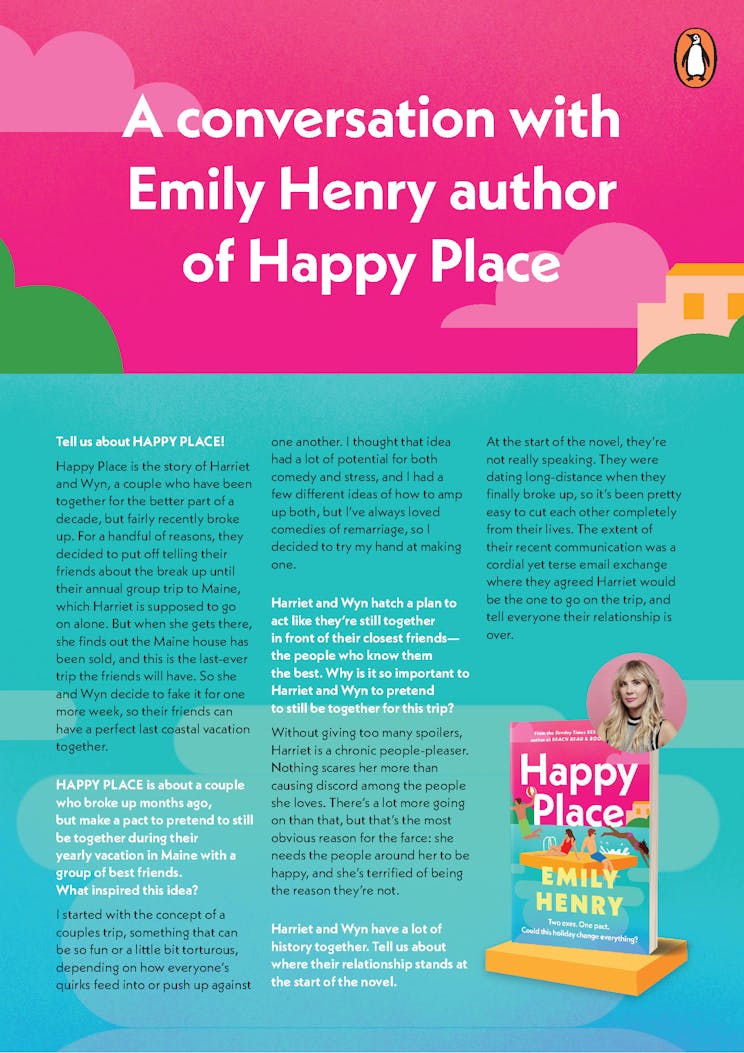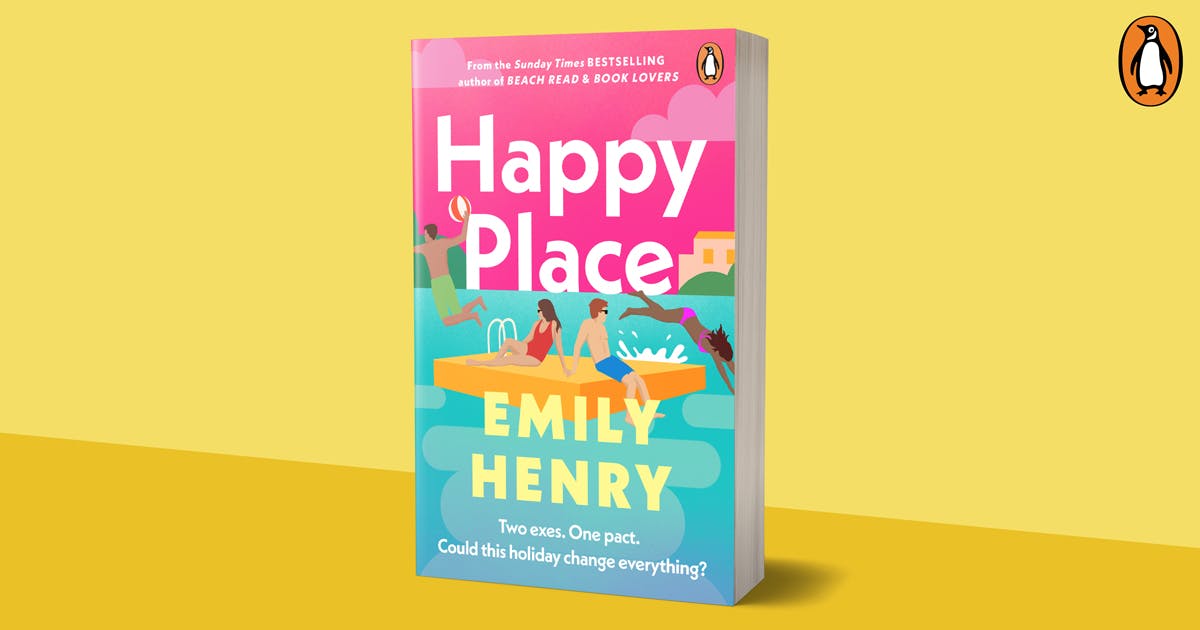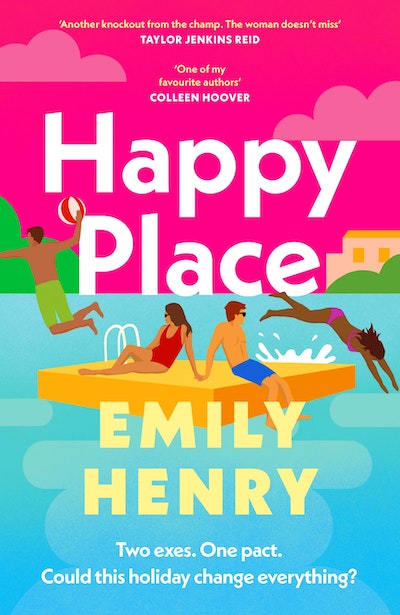Dive into the mind of romance novel superstar, Emily Henry as she discusses all things Happy Place
Download a PDF of the Q&A here! Or read on for the full conversation...

Tell us about HAPPY PLACE!
Happy Place is the story of Harriet and Wyn, a couple who have been together for the better part of a decade, but fairly recently broke up. For a handful of reasons, they decided to put off telling their friends about the break up until their annual group trip to Maine, which Harriet is supposed to go on alone. But when she gets there, she finds out the Maine house has been sold, and this is the last-ever trip the friends will have. So she and Wyn decide to fake it for one more week, so their friends can have a perfect last coastal vacation together.
HAPPY PLACE is about a couple who broke up months ago, but make a pact to pretend to still be together during their yearly vacation in Maine with a group of best friends. What inspired this idea?
I started with the concept of a couples trip, something that can be so fun or a little bit torturous, depending on how everyone’s quirks feed into or push up against one another. I thought that idea had a lot of potential for both comedy and stress, and I had a few different ideas of how to amp up both, but I’ve always loved comedies of remarriage, so I decided to try my hand at making one.
Harriet and Wyn hatch a plan to act like they’re still together in front of their closest friends—the people who know them the best. Why is it so important to Harriet and Wyn to pretend to still be together for this trip?
Without giving too many spoilers, Harriet is a chronic people-pleaser. Nothing scares her more than causing discord among the people she loves. There’s a lot more going on than that, but that’s the most obvious reason for the farce: she needs the people around her to be happy, and she’s terrified of being the reason they’re not.
Harriet and Wyn have a lot of history together. Tell us about where their relationship stands at the start of the novel.
At the start of the novel, they’re not really speaking. They were dating long-distance when they finally broke up, so it’s been pretty easy to cut each other completely from their lives. The extent of their recent communication was a cordial yet terse email exchange where they agreed Harriet would be the one to go on the trip, and tell everyone their relationship is over.
HAPPY PLACE combines the fake-dating and second-chance romance tropes. What did you enjoy about writing a love story with these tropes?
For a long time, I think tropes got a bad rap. And then using them as the starting or focal point of a story became really popular. Now I see it going back the other way a bit, because as we all know, tropes in themselves don’t really matter. The characters make them matter. So whenever I start a story by thinking about trope, I’m really just looking for whether that trope presents me with at least one lead character. In this case, as soon as I started thinking about fake dating, I thought about a real couple finding themselves in a situation where they had to keep performing their relationship after it had ended.
I loved the challenge of trying to find a use of this trope that would feel somewhat realistic and plausible, and I also really enjoyed the challenge of seeing whether I could bring a couple back together after they’d fallen apart to a point where they really thought there was no saving what they had.
Maine is a beautiful setting and you do such a great job of transporting readers there. Tell us about your decision to set the book here. Do you have any personal connections to Maine?
Before this book, most of my personal connection to Maine was actually just through story. I love how big of a character the Maine settings are in Stephen King stories, and I—like Harriet—really love the Maine setting of Murder, She Wrote, even if it was actually filmed in California. My mom’s family was from New England, so she had a lot of love and nostalgia for Maine, but I’d actually never been there.
That’s partly why I chose it. I wanted an excuse to take a research trip. My editor is also from Maine, so I knew she’d help me catch anything inaccurate, which I’m always very concerned with. I really dislike when you’re reading a book and you get jarred out of the story just because of something small that doesn’t match up with your knowledge of a place. It’s also why I’m prone to using fictional cities: so I can take my favorite parts of several close together settings and combine them, without disrupting someone’s reading experience with anachronisms.
In addition to providing readers with an irresistible love story, HAPPY PLACE explores the intricate dynamics of friendships that withstand years and time apart. What inspired you to give friendships such an important role in a romance novel?
I feel so lucky to have a lot of friends around me who I’ve been close to since high school, and one I’ve been close to since the fifth grade. When you’re friends that long, it’s really interesting, because you can look back on all of your different phases, and it hardly makes any sense that your friendship still works, because you’re entirely different people from when you met. And those past versions of yourselves made sense as friends, just as these current versions do. But there are also plenty of growing pains, and plenty of relationships can’t withstand those transformations.
Harriet’s and Wyn’s complicated romantic relationship is knit tightly into their complicated friendships with this group of people. They’ve all known each other since college, and even though they’re far flung across the country, this breakup is really the first time the friendships will be put to the test. There’s no way this story works without that. Those are the stakes, for Harriet and Wyn. Once they admit they’ve broken up, it’s going to change everything for this group of people, and they both have their individual fears of what that might look like.
The characters in HAPPY PLACE have been friends for years, but over time their lives have changed and their friendships have changed as a result. Have you ever experienced changes in your own friendships? Did you use those experiences to write HAPPY PLACE?
Oh, definitely! It’s really wild, to look at a close group of friends from a certain time in your life and realize you’re all in totally different places now. And you’ll come together for reunions or weddings or whatever, and pick right back up in that liminal space, but then you all go back to your lives. In your early thirties, I think, is when this first becomes especially visible.
You’ve got friends with kids old enough to be in school, friends who are single, friends on second marriages, friends who are trying to open businesses, friends who’ve just decided to go back to school, and everything in between and beyond those. For friendships to last across seasons of life, there has to be a kind of flexibility and true acceptance that’s not necessarily easy to find or create. I’m always fascinated by those moments of change or transformation. I’m always writing coming of age stories, and this one is very much about that particular moment of transformation, when a relationship of any kind has to either grow or let go.
Did any of your personal friendships inspire the ones in the book?
Definitely. No one is exactly a person from my real life, but I always sprinkle little details in. One of my best friends from high school is now a lawyer in New York, whose partner is also a lawyer, like Sabrina and Parth. Another one of my closest friends is a painter-slash-farmer with vegetable tattoos on her knuckles, like Cleo. Cleo also has this incredible gift for saying no, and one of my best friends is very much that way. She has no issue telling people how she feels and what she wants (or doesn’t want), and that’s something I really admire about her. And Kimmy is definitely an amalgam of several close friends. Beyond that, there are so many little details from own college experience sprinkled through the book.
Harriet often goes out of her way to please others, and Wyn can be reluctant to open up about himself and his feelings. Their perceptions of themselves have big effects on their relationship, and they have to work through them in order to move forward. Why did you decide to write a love story with characters like them?
I’m pretty much always writing through something I’m trying to work out. I knew eventually I’d have to write a book about people pleasing because, unfortunately, it’s been such a huge driver in my own life and something I am constantly working to let go of. You’d think that tendency would make relationships go smoothly, and in casual relationships, that might be the case, but in intimate ones, it’s such a huge roadblock to not be honest about what you want or need.
When you’re used to people-pleasing, it’s often hard to even figure out what you want or need, because you’re so used to looking outward for clues as to what you should be doing. It can often feel like your primary need is to just keep the peace, but a lot of times ‘keeping the peace’ is just code for avoidance, and avoiding problems often leads to more problems. I think Harriet is an exceptionally relatable character, but she’s also going to be a very frustrating one. We like our characters to have agency, to do the thing that will obviously, from our point of view, fix things. In real life, conflict is so, so, so hard for many of us, but when you see it all written out in a scene, and the solution to a problem seems so obviously to be just talk about, that’s hard for us as readers.
So having a character like Harriet felt important, because I and so many others are her, and I wanted an empathetic look at that type of person that also underscored the way these tendencies backfire.
Harriet is a neurosurgery resident who also dabbles in pottery. Did you do any research on this profession and hobby before writing and if so, did anything surprise you?
Oh, yes. I did a lot of research, but still included very little of the neurosurgery aspects in the book, because frankly, I knew I wasn’t even close to expert enough to be confident I was discussing it accurately, but also because a huge part of Harriet’s story is that she spends a lot of time trying not to think about work. She’s got her life divided in a way, and that compartmentalization was important for her arc.
Since I had never once in my life considered being a neurosurgeon, pretty much all the information I gathered surprised me on some level. But probably the most helpful research I did was actually reading message boards for surgical residents, where I could see what they complain about. One common complaint among residents was that so many residents would be assisting on a surgery that they couldn’t even see what was going on, let alone actually do anything. They’d talk about the irritation of going through the whole scrub-in process for nothing. The complaints from these message boards inspired some bits of Harriet’s story.
Without giving anything away, what was one of your favorite scenes to write
I really enjoyed writing the first morning at the Maine house, when Harriet wakes up. I’m not even sure why, but that one stands out to me.
Each of the characters in HAPPY PLACE is so distinct. How did you juggle writing all of their personalities while keeping focus on Harriet and Wyn?
This was a real challenge after writing three books with smaller central casts. Even though I felt like I knew all of these characters well, it was a struggle figuring out how to actually get that on the page without relying too heavily on telling the audience about them.
On a very practical level, I made sure that Harriet had one-on-one scenes with everyone, where we could see a bit more of their history and dynamic together. The one exception is, I’m not sure if she has a scene that’s just her and Kimmy, but Kimmy is a scene-stealer, in my opinion, so I wasn’t as worried about readers not knowing her. She is unapologetically herself, and a true weirdo, in the best way.
What character in HAPPY PLACE do you relate to most?
I put a little bit of myself into every character, but I find Harriet’s issues painfully relatable. I also relate to some of Sabrina’s more… challenging traits. When she’s hosting, she gets into Cruise Director mode, in which she has a very idea of how things are supposed to go, and it’s really hard for her to let go of that idea when circumstances force her to shift gears.
If you had to pick your ‘happy place’ what would it be?
Honestly, I really, really, really love being at home. That was the first thing that came to mind, and I feel so lucky that that’s true. But beyond that, Lake Michigan is my happy place. Something about being there wakes me up, and makes me feel truly present in a way that I don’t always.
What do you hope readers take away from reading HAPPY PLACE?
It’s so easy to feel stuck on a track in your life. And it’s easy to keep putting your happiness just beyond an imaginary finish line on that track, instead of hopping the rails. I hope this book can be a reminder to someone that there’s no one right path, that they’re allowed to change their mind about what they want, and that they deserve to be happy, even if that looks different for them than it does for other people.












-.jpg?w=690&h=344)
